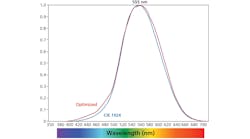As well as producing the 0.5 W and 1.0 W Rigel series, Nichia has developed 5.5 W and 11 W devices under the name of Kirameki, which have a luminous flux of 200 lm and 400 lm respectively.
Drake Stalions, sales manager with Nichia America, described the company's Rigel series of power LEDs, targeting lighting and other applications. The mid-power Rigel is a 150 mA, 0.5 W device in a ceramic package measuring 3.5 x 3.5 x 0.8 mm.
One of the key features of this product, explained Stalions, is that the efficacy does not fall dramatically for warmer white devices. Cool white products (4600-9000 K) have an efficacy of 38 lm/W and a luminous flux of 20 lm, while the figures for the warm white incandescent-equivalent (2800 K) device are 31 lm/W and 17 lm. Devices corresponding to cool fluorescent (4200 K) and warm-white fluorescent (3500 K) are also available, with intermediate flux and efficacy values.
Later this year, Nichia will start sampling its 1.0 W Power Rigel, with a luminous flux of 40 lm. The device draws 350 mA of current and has a small-footprint, low-profile package measuring 4.5 x 4.5 x 1.3 mm. Production will commence next year, at which point Stalions expects the Power Rigel to become the most cost-effective power white LED on the market.
Kirameki provides 400 lm for automotive
Demonstrating that Nichia has in no way been left behind in the high-power LED market, Stalions also described the company's new Kirameki device developed for the automotive forward lighting market.
Two variants of Kirameki were discussed; a 5.5 W device with a flux of 200 lm, and an 11-W device with a flux of 400 lm. The packages measure 14 x 9 x 5.6 mm and contain multiple chips. Both devices operate at 700 mA and produce warm-white light at 4300 K, which is the desired white color for automotive forward lighting.
Another critical feature for this application, demonstrated by Kirameki, is that both the package and the die should have a very small optical area, in order to achieve the required beam pattern with multiple devices.
The devices have an efficacy of 36 lm/W and will operate within the temperature range specified for automotive applications of -40 to +105°C.
The maximum junction temperature for the devices is 150°C. Both packages have an extremely low thermal resistance of 6°C/W for the 5.5. W device and 3°C/W for the 11 W device. Because of these values, the devices are not suitable for reflow soldering and must be mechanically mounted.
Samples have been sent out to several customers, and Nichia is awaiting feedback before finalizing all the device specifications. Stalions said that the Kirameki is likely to be available for use in automotive applications by 2007.




